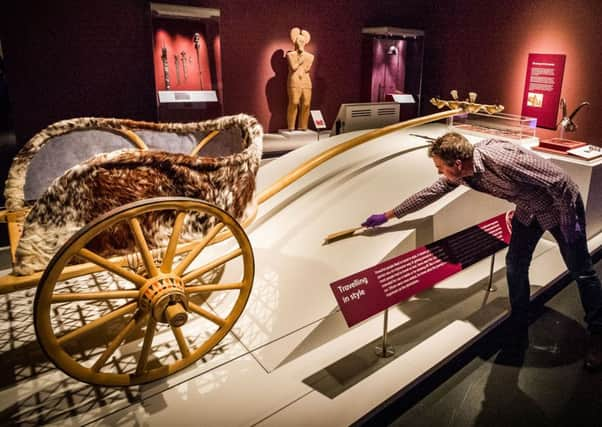Iron Age '˜Ferrari' chariot put on display in Edinburgh


The National Museum of Scotland, whose staff have recreated the only Iron Age chariot to be found in the country, has given it pride of place in its new blockbuster show.
Dating back to around 470 BC, it was found encased in mud on a building site at Newbridge, near Edinburgh Airport 15 years ago. Although the organic materials had rotted, corrosion of the iron in the chariot had fossilised traces of wood and leather.
Advertisement
Hide AdAdvertisement
Hide AdOther highlights of the Celts exhibition include a horned helmet once owned by Sir Walter Scott, author of the Waverley Novels, which experts believe was an Iron Age cap for a pony.
Visitors to the show will also get the chance to see the Iron Age gold torcs discovered by safari park keeper David Booth using a metal detector in a field in Stirlingshire seven years ago.
The exhibition also features a special display devoted to the animal-headed carnyx musical instrument, including one found in Banffshire in 1816 which dates back to 80-200 AD.
Many of the 350 objects going on display at the museum from today have come on loan from collections across Europe and have never been seen in Scotland before.
They include the star exhibit, the spectacular Gundestrup cauldron, which is more than 2000 years old and has rarely been allowed out of Denmark since being discovered in a peat bog in 1891.
Among the most recent finds in the exhibition, which runs until 25 September, are an Iron Age bronze torc and brooch from Auldearn, near Nairn, while the exhibition also features a display devoted to a hoard of treasure found underneath a slab in a church on St Ninian’s Isle, in Shetland, in 1958.
The show, the first major exhibition devoted to the Celts for more than 40 years, has been created in collaboration with the British Museum in London.
Advertisement
Hide AdAdvertisement
Hide AdExhibits coming on loan include treasures recovered from the River Thames, including the famous Waterloo Helmet, which dates back to 150 BC, and the bronze Battersea Shield, which is regarded as one of the most significant pieces of Celtic art found in Britain.
Dr Fraser Hunter, principal curator of the Iron and Roman Age collections at the museum, said: “This is a once-in-a-lifetime chance to see masterpieces of Celtic art from all across Europe. These allow us to explore connections and differences across the Europe of 2000 years ago, to think about what the idea of Celts means, and to see the power that this art gave to objects which people cherished.”